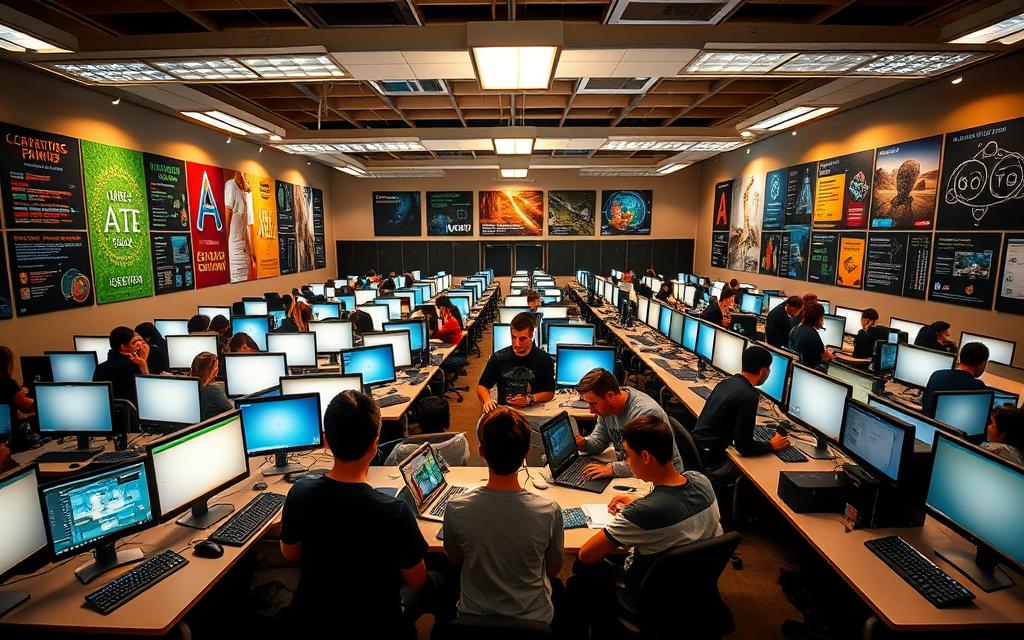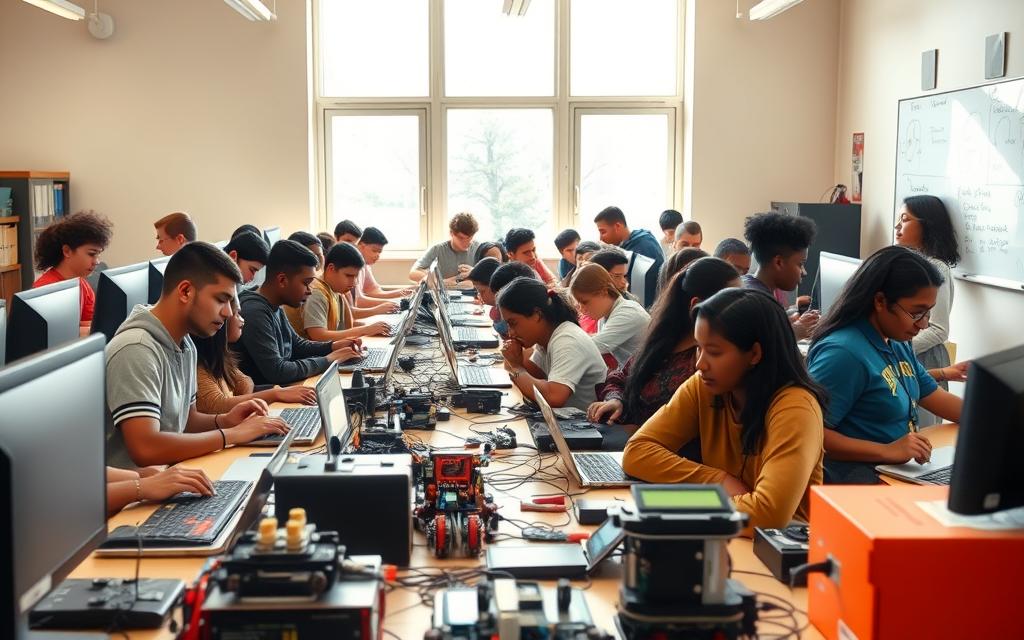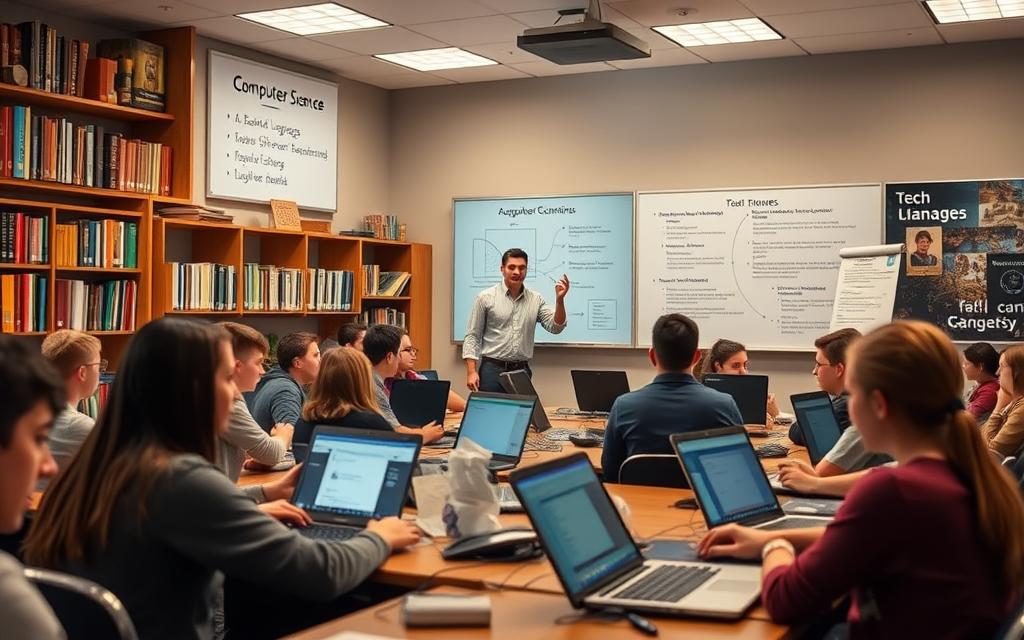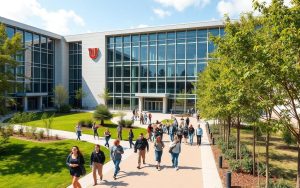Table of Contents
Modern education increasingly emphasizes coding and technical literacy. Many U.S. schools now integrate programming into their curriculum, preparing students for a digital future.
Data reveals significant disparities in access to computer science courses. While 91% of Asian American learners attend institutions offering these programs, only 67-77% of Black and Hispanic peers have similar opportunities.
Gender gaps persist, with female students enrolling in half as many programming classes as their male counterparts. Urban districts typically provide more advanced options compared to rural areas.
Despite growing course availability, challenges remain. Teacher shortages and limited resources often hinder skill development. Yet, industry demand for coding abilities continues rising across all sectors.
Introduction: The State of High School Computer Science
California leads the nation in tech employment and education innovation. The state employed 28.7% of U.S. programmers in 2020, driving demand for skilled talent. Schools now offer over 5,000 computer science courses, up from fewer than 1,000 in 2010.
Career Technical Education (CTE) programs make up 40% of these courses. They blend hands-on training with academic rigor, preparing students for software development roles. The Bureau of Labor Statistics projects a 73% job growth in this field by 2031.
The University of California system now accepts computer science as a lab science credit. This change reflects its importance in modern education. Yet, racial disparities persist—Black and Hispanic learners enroll at lower rates than Asian American peers.
Industry partnerships help shape curricula, emphasizing computational thinking. This skill set extends beyond coding, fostering problem-solving abilities. However, teacher shortages remain a barrier, as detailed later.
How Good Is the Average High Schooler at Computer Science?
AP exam data highlights disparities in technical comprehension. While 67% pass Computer Science Principles, Calculus AB sees an 80% success rate. This gap suggests foundational programming concepts remain challenging for many students.
Schools offering AP CSA (Java-based) versus basic courses create uneven skill levels. A Dewey Smart study found 52% of Columbia freshmen lacked coding experience. Yet, self-taught learners often excel by building practical projects like GPA calculators.
ETS assessments reveal computational thinking lags behind rote programming. Colleges report a “CS1 gap,” where introductory classes reset knowledge baselines. Python proficiency now rivals Java among incoming freshmen.
Top universities prioritize GitHub portfolios showcasing real-world skills. Internship recruiters increasingly review repositories, debunking the myth that coding alone equals computer science mastery.
The Rise of Computer Science in High School Curricula
Texas became the first state to require computer science for graduation, signaling a national shift. Over 33 states now mandate K-12 standards, per Code.org. This policy wave reflects growing demand for tech-savvy graduates.

Growth of AP and CTE CS Courses
AP Computer Science Principles enrollment jumped 216% from 2018–2022. Career Technical Education (CTE) programs fuel this growth, blending coding with hands-on projects. Perkins V funding allocated $1.3B annually to expand these pathways.
Industry certifications like AWS and CompTIA now count toward diplomas in 12 states. Dual enrollment with community colleges lets students earn credits early. UC Berkeley’s Beacon initiative partners with 120 schools to bridge gaps.
State Standards and Their Impact
Massachusetts’ 2022 Digital Literacy standards require computational thinking across subjects. Contrast this with Texas, where standalone courses fulfill graduation requirements. Both models aim to prepare learners for college or careers.
Corporate investments exceed $900M, funding teacher training and infrastructure. Yet disparities persist—urban districts often offer advanced programming labs, while rural schools rely on virtual programs. States like Georgia prioritize equity through grants for underserved areas.
Key Challenges in High School CS Education
Schools nationwide face three major obstacles in delivering quality computer science education. Teacher shortages, packed schedules, and uneven resource distribution limit opportunities for students.
Shortages of Qualified CS Teachers
Over 68% of California teachers lack formal credentials in computer science. NSF data reveals a 53% attrition rate among new hires, driven by salary gaps—educators earn 32% less than industry peers.
Programs like NYC’s $81M CS4All initiative aim to close this gap. UTeach certifications also help, yet rural schools often rely on educators teaching multiple subjects.
Limited Curriculum Space
AP requirements compete for slots in student schedules. Only 40% of schools offer dedicated courses, forcing many learners into overcrowded electives.
Blended models with CodeHS or Coursera provide flexibility. However, the $2,500 average cost for teacher PD remains a barrier.
Equity in Access to CS Courses
Title I schools lack infrastructure for advanced labs. Stanford research shows a 1:4 gender match between teachers and students improves female retention by 22%.
CTE funding reallocation could bridge gaps. States like Georgia prioritize grants for underserved areas, but nationwide equity remains uneven.
Demographics and Participation in High School CS
Educational equity gaps persist in computer science participation across U.S. high schools. Black students represent 15% of enrollment but only 8% of AP CSA test-takers. Schools serving high-poverty populations offer these courses 39% less frequently than affluent districts.

Gender Disparities in Enrollment
Female participation remains below 35% in advanced programming classes. Districts with female instructors see 34% better gender parity. Organizations like Girls Who Code demonstrate impact—78% of participants pursue tech degrees.
Key interventions show promise:
- Middle school coding camps increase early exposure
- Project-based learning reduces stereotype threat
- Industry mentorships build confidence
Addressing Racial and Economic Barriers
Oakland Unified’s equity audit revealed stark contrasts. Magnet schools offered 12 advanced CS options, while neighborhood sites averaged two. ESSER funding allocations aim to close these gaps:
| Initiative | Funding | Target Group |
|---|---|---|
| Device Access Grants | $120M | Title I Schools |
| HBCU Pipeline Programs | $47M | Black Students |
| Rural Broadband Expansion | $89M | Remote Communities |
The Emerging Scholars program boosts retention through peer support. Participants complete advanced courses at triple the rate of non-members. Such models prove systemic change is possible with targeted investment.
How High School CS Prepares Students for College
Colleges increasingly recognize high school computer science coursework for credit. This shift creates academic and financial advantages for students pursuing tech degrees. Early exposure to programming concepts builds confidence in university-level courses.

Dual Enrollment Programs
Tennessee’s Promise initiative demonstrates the power of dual enrollment. Participants earn college credit while completing diploma requirements, saving an average $9,000 per student. NACEP data shows 21% higher graduation rates among these learners.
Key benefits include:
- Articulation agreements with 82% of community colleges
- Early access to advanced programs like Stanford’s Code in Place
- NSF-funded Early College HS initiatives covering full tuition
AP CS and College Credit
82% of institutions accept AP Computer Science Principles for credit, per College Board. Top universities like MIT grant placement advantages for scores of 4-5. This differs from IB recognition, which varies by department.
Cost comparisons reveal stark advantages:
| Option | Average Cost | Credit Value |
|---|---|---|
| AP Exam | $96 | 3-8 credits |
| Dual Enrollment | $0 (subsidized) | 3-12 credits |
| Traditional College | $900/course | 3 credits |
UC/CSU systems now count CS toward A-G requirements. This policy change reflects the growing importance of technical education in college preparedness.
Career Paths for High School CS Students
Tech careers offer diverse opportunities for students with programming skills. From traditional roles to emerging fields, computer science opens doors across industries. Early exposure through courses and projects helps learners identify their ideal trajectory.

Industry Jobs: Software Engineering and Beyond
Google reports $191K starting salaries for L3 software engineer roles. FAANG companies attract top talent, but startups offer faster growth potential. Key differences:
- Big Tech: Structured mentorship, stock options
- Startups: Broader responsibilities, equity stakes
- Cybersecurity: CompTIA Security+ certs enable entry-level roles
IBM’s P-TECH model combines high school with associate degrees. Graduates often secure jobs at partner firms like SAP. Quant trading firms recruit competition winners, valuing algorithmic skills over traditional degrees.
Academic and Research Careers
Only 3.8% of computer science PhDs become professors, per NSF data. Undergrads can access research through REU programs at MIT and Stanford. Funding contrasts sharply:
| Path | Median Salary | Funding Source |
|---|---|---|
| Academic Research | $82K | NSF Grants |
| Industry R&D | $145K | Corporate Budgets |
Emerging fields like bioinformatics blend technology with medicine. Meta’s university pipeline converts interns to full-time hires at 73% rates. LinkedIn optimization helps students showcase projects to recruiters.
Whether pursuing a college degree or certifications, career success stems from continuous skill-building. The key lies in matching personal strengths with market needs.
The Role of Extracurriculars and Personal Projects
Beyond classroom walls, hands-on coding projects shape future tech leaders. Carnegie Mellon admissions data reveals 73% of top applicants showcase GitHub portfolios. These repositories demonstrate practical skills that often surpass textbook knowledge.
Competitions spark lasting interest in technology. FIRST Robotics participants show 89% higher STEM enrollment rates.
“Our alumni pursue engineering degrees at triple the national average,”
notes Dean Kamen, founder of FIRST.
Hackathons accelerate learning through intense collaboration. Major League Hacking reports:
- 42,000+ annual participants nationwide
- Python and JavaScript as most-used languages
- 89% internship placement via Dewey Smart’s program
Open-source contributions build professional experience early. Teens contributing to projects like VS Code gain:
- Real-world version control practice
- Code review exposure
- Networking with senior developers
MIT’s Battlecode competition challenges students to create AI strategies. Winners often secure research positions, proving project-based learning opens doors.
Educators recommend documenting projects for college applications. Stanford admissions officers emphasize:
- Process explanations over final products
- Failure analysis showing growth
- Community impact measurements
Raspberry Pi initiatives demonstrate programming‘s creative potential. From smart mirrors to plant sensors, these projects make abstract concepts tangible.
Teen-developed mental health apps highlight coding‘s societal value. The CDC features several in their youth resources, proving technology can address real needs.
Schools supporting maker spaces see 34% higher female participation in computer courses. Strategic mentorship bridges gaps between classroom theory and industry practice.
How Schools and Policymakers Can Improve CS Education
Policy reforms and funding allocations reshape technical training landscapes. The $65M NSF CSforAll grants demonstrate growing commitment to equitable education. Districts now blend computational thinking with core subjects, creating more accessible pathways.
Teacher Training and Support
ISTE reports 58% of teachers need cross-disciplinary professional development. Successful models like NYC’s CS4All show how microcredentials boost competency. Key strategies include:
- Industry externships at firms like Google
- Denver’s endorsement pipeline with CU Boulder
- Reciprocity agreements between states
Chicago’s Skyline program reduced attrition by 41% through:
| Initiative | Impact |
|---|---|
| Stipended summer institutes | 72% skill retention |
| Mentor teacher networks | 3:1 ROI on PD investment |
Integrating CS with Other Subjects
The U.K.’s Computing at School initiative proves blending courses works. AR/VR applications bring history to life while teaching Python basics. CSTA standards provide frameworks for:
- Bioinformatics modules in biology
- Data visualization in social studies
- Algorithmic thinking in music
ESSA Title IV-A funds support these innovations. One California district saw 37% higher engagement when combining:
“Literature analysis with natural language processing projects creates unexpected synergies,”
notes Dr. Elena Torres, STEM coordinator.
Conclusion: The Future of High School Computer Science
The landscape of technical education evolves rapidly, with AI tools reshaping learning approaches. GitHub Copilot now assists 38% of students in debugging assignments, hinting at technology-augmented curricula ahead.
Universal access to computer science programs becomes critical. Districts piloting Spanish-language coding courses report 42% higher Hispanic enrollment. Industry partnerships, like Amazon’s Future Engineer initiative, bridge resource gaps in underserved schools.
Competency-based transcripts may soon replace traditional grading. Early adopters track project portfolios and GitHub contributions. These changes prepare learners for college and career demands where skills outweigh certificates.
As CTE-STEM pathways expand, Dewey Smart’s tutoring model shows promise—participants achieve 89% AP pass rates. The future belongs to adaptable students mastering both algorithmic thinking and emerging tools.
FAQ
What level of programming skills do most high school students have?
Many students grasp basic coding concepts, like loops and conditionals, often in Python or JavaScript. Some excel through AP courses or personal projects, while others may only have introductory exposure.
How does high school computer science prepare students for college?
Advanced Placement (AP) courses and dual enrollment programs offer college credit. These classes build problem-solving skills and foundational knowledge, easing the transition to higher education.
Are there gender or racial gaps in high school CS participation?
Yes. Women and underrepresented minorities often enroll less due to lack of access, stereotypes, or limited mentorship. Schools are working to close these gaps through inclusive programs.
Can high school coding experience lead to tech jobs?
Absolutely. Internships, hackathons, and strong portfolios help students land roles in software engineering, data analysis, or IT. Early experience accelerates career growth.
What challenges do schools face in teaching computer science?
A> Teacher shortages, outdated equipment, and competing academic priorities limit progress. States are adopting standards, but funding and training remain hurdles.
Do extracurricular activities boost CS skills?
A> Robotics clubs, coding competitions, and open-source projects deepen understanding. Hands-on learning often surpasses classroom theory in building real-world expertise.









